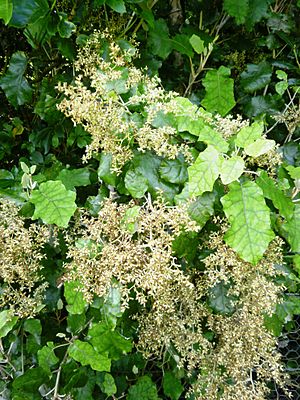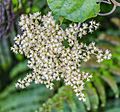Rangiora (plant) facts for kids
Quick facts for kids Rangiora (plant) |
|
|---|---|
 |
|
| Scientific classification | |
| Kingdom: | |
| (unranked): | |
| (unranked): | |
| (unranked): | |
| Order: | |
| Family: | |
| Tribe: |
Senecioneae
|
| Genus: |
Brachyglottis
|
| Species: |
B. repanda
|
| Binomial name | |
| Brachyglottis repanda J.R.Forster & G.Forster
|
|
The Brachyglottis repanda is a special plant from New Zealand. It's also known as rangiora or bushman's friend. This plant is a small, bushy tree or a tall shrub.
It can grow quite tall, reaching about 5 to 7 meters (16 to 23 feet) high. Its leaves are unique, with a groove on their stems (called petioles) that can be up to 10 cm (4 inches) long. The large leaves have a soft, furry underside. Because of this soft texture, some people have even called them "bushman's toilet paper"!
In the Māori language, this plant has many names. Besides rangiora, it's also known as kōuaha, pukapuka, pukariao, puke-rangiora, raurākau, raurēkau, whārangi, or whārangi-tawhito.
Contents
What Rangiora Looks Like
The rangiora plant is a shrub or small tree. It can grow up to 6 meters (about 20 feet) tall. It has bark that feels like cork.
Its leaves are tough and leathery. They are usually 5 to 25 cm (2 to 10 inches) long and 5 to 20 cm (2 to 8 inches) wide. These leaves hang from stems called petioles, which are 8 to 10 cm (3 to 4 inches) long and have grooves.
The top of the leaves is a pale green color. The underside is white because it's covered with many tiny white hairs.
Flowers and Seeds
Rangiora flowers bloom from August to October. Its flowers grow in big clusters called panicles. Each cluster has 6 ribs and small leaf-like parts called involucral bracts that are 3mm long.
The flower heads are about 5mm across. Each head has 10 to 12 small yellow flowers called florets.
After flowering, the plant produces seeds. These seeds are oblong, about 1 to 1.8 mm long. They have a rough, yellow, feathery top called a pappus, which is 2 to 3 mm long.
The plant fruits from November to December. Its seeds are spread by the wind.
Where the Name Comes From
The name Brachyglottis comes from two ancient Greek words. Brachus means "short." Glottis refers to the vocal parts in your throat.
The second part of the name, repanda, means "wavy" or "uneven." This describes the wavy edges of the plant's leaves.
How to Grow Rangiora
It's quite easy to grow Brachyglottis repanda. You can start new plants from seeds or from cuttings.
However, these plants might not live for a very long time. They also need to be trimmed back quite a bit after they finish flowering. This helps them stay healthy and grow well.
Rangiora in Māori Culture
The Māori people used the rangiora plant for many helpful purposes. They used the leaves to help heal wounds and old sores.
The plant's gum was sometimes chewed to help with bad breath. However, it was known that the gum was not safe to swallow.
A historian named Richard Taylor wrote about other uses. He said that Māori used rangiora leaves to wrap cakes made from Hīnau berry flour. These cakes were then cooked in a traditional Hāngi (earth oven).
The leaves were also used to line baskets. These baskets held the fine parts of Raupō pollen. This pollen was used to make a type of bread.
Is Rangiora Safe?
A scientist named Bernard Aston found something important about rangiora. He reported that honey made by bees from rangiora flowers can be harmful. Because of this, Māori people never collected honey when rangiora was in bloom.
The plant can also be unsafe for farm animals, especially horses. If animals eat too much of it, they might become unwell.
Images for kids
See also
 In Spanish: Rangiora para niños
In Spanish: Rangiora para niños



